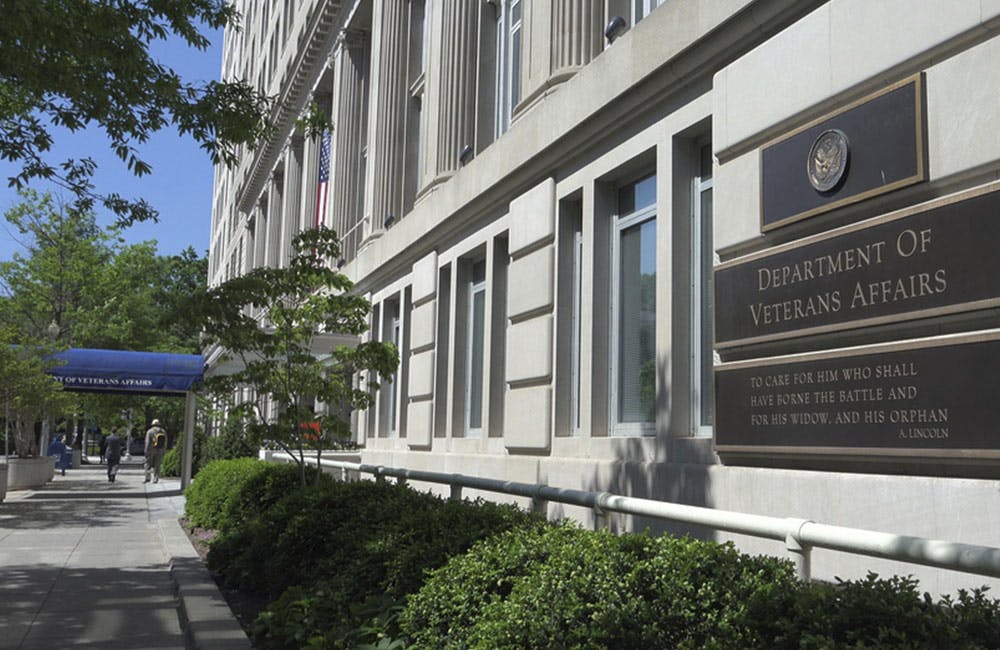Defense Secretary Outlines Path to Efficiency
Hiring freeze and workforce cuts are among new strategies to eliminate waste and reinforce core DOD mission, Hegseth says.

Defense Secretary Pete Hegseth said that enhancing cybersecurity and leveraging advanced technology will help eliminate waste within DOD, during a recent address to Defense Department employees.
“We’re asking the services to plan. It’s not a cut,” Hegseth said. “It’s refocusing and reinvesting existing funds into building a force that protects you, the American people.”
Last week, Hegseth said that the new administration is refocusing DOD toward critical priorities, with a significant emphasis on leveraging advanced technology. The address, on reevaluating the probationary workforce to align with President Donald Trump’s directives to shrink government, outlined the ways that Hegseth is evaluating priorities for the Pentagon.
Hegseth cited autonomous vehicles and cybersecurity as critical emphases.
“It’s very stated very clearly here: southwest border activities, combating transnational criminal organizations, an audit, nuclear modernization, Virginia class submarines, the Iron Dome, attack drones, UAVs, cybersecurity, core readiness training and the defense industrial base,” said Hegseth during the address. “They’re too important, as are many other things.”
The cuts to climate change programs and “excessive bureaucracy,” according to a Pentagon press release, amount to approximately 5-8% of DOD’s budget (appreciate $50 million annually) in each of the next five years. Darin Selnick, DOD acting undersecretary of defense for personnel and readiness, also reiterated Hegseth’s priorities in a statement last week.
“It is simply not in the public interest to retain individuals whose contributions are not mission-critical,” Selnick wrote. “Taxpayers deserve to have us take a thorough look at our workforce top-to-bottom to see where we can eliminate redundancies.”
Earlier this month, Hegseth told reporters that he will be working in concert with the Department of Government Efficiency (DOGE) to eliminate unnecessary spending in DOD, but that the cuts will not hurt readiness.
“We want to find efficiencies … like the way we acquire weapon system, our procurement. There’s plenty of places where we want the keen eye of DOGE, but we’ll do it in coordination,” Hegseth said in Germany during a Feb. 11 press availability. “We’re not going to do things that are to the detriment of American operational or tactical capabilities”
During a town hall at AFRICOM headquarters on Feb. 11, Hegseth said that the Ukraine war taught the world lessons on agility, better acquisition and efficient technology for the future fight.
“In a budget constrained environment, [the military needs to] ensure maximum resources. When we get a streamlined acquisition – a lesson learned from conflicts in Ukraine – and the technologies that can be grabbed and fielded and commercially available that can be provided for collaboration,” Hegseth said. “It’s the same with large development systems, making sure that we’re investing in those need for the fight five, 10 and 15 years in the future.”
According to Hegseth’s address, DOD will also implement a hiring freeze and evaluate probationary employees. DOD officials said in December that the department needs to hire more skilled cybersecurity professionals to bolster defense in the cyber domain.
This is a carousel with manually rotating slides. Use Next and Previous buttons to navigate or jump to a slide with the slide dots
-

DOD Accelerates Software Modernization with Agile DevSecOps Push
The Pentagon's software implementation plan tackles cultural hurdles and integrates security early to deliver critical capabilities faster.
6m read -

White House Unveils AI Action Plan to Secure Global Dominance
The strategy outlines steps to accelerate private sector innovation, build critical infrastructure and advance U.S. leadership in AI policy and security.
3m read -

VA's Platform One Powers Rapid Innovation to Bolster Digital Services
VA's Platform One accelerates software development timelines from weeks to hours, ultimately enhancing digital services for veterans.
5m read -

Pentagon's $200M AI Contracts Signal Broader Effort to Transform Talent
The Army is leveraging Silicon Valley, reservist programs and new hiring strategies to integrate critical digital skills in its ranks.
5m read -

Inside DOD’s Push to Grow the Cyber Workforce Through Academia
Diba Hadi gives her first interview since becoming principal director of the DOD’s Cyber Academic Engagement Office.
15m listen -

The Next AI Wave Requires Stronger Cyber Defenses, Data Management
IT officials warn of new vulnerabilities posed by AI as agencies continue to leverage the tech to boost operational efficiency.
5m read -

Federal CIOs Push for ROI-Focused Modernization to Advance Mission Goals
CIOs focus on return on investment, data governance and application modernization to drive mission outcomes as agencies adopt new tech tools.
4m read -

Agencies Push Data-Driven Acquisition Reforms to Boost Efficiency
New initiatives aim to increase visibility of agency spending, improve data quality and create avenues to deploy solutions across government.
5m read -

DOD Turns to Skills-Based Hiring to Build Next-Gen Cyber Workforce
Mark Gorak discusses DOD’s efforts to build a diverse cyber workforce, including skills-based hiring and partnerships with over 480 schools.
20m listen -

Navy Memo Maps Tech Priorities for the Future Fight
Acting CTO’s memo outlines critical investment areas, from AI and quantum to cyber and space, as part of an accelerated modernization push.
5m read -

DOD Can No Longer Assume Superiority in Digital Warfare, Officials Warn
The DOD must make concerted efforts to address cyber vulnerabilities to maintain the tactical edge, military leaders said at HammerCon 2025.
4m read -

Marine Corps Operation StormBreaker Slashes Software Delivery Timelines by 17x
New program aims to deliver critical digital capabilities to warfighters at the "speed of relevance" by overhauling traditional processes.
4m read
















